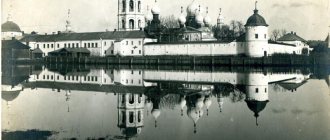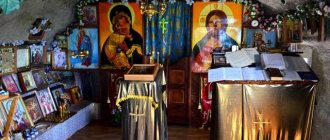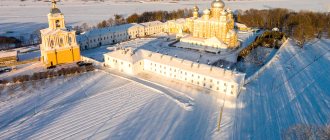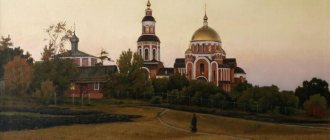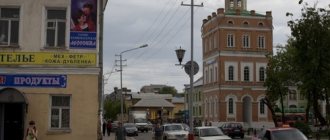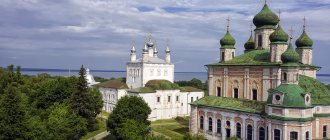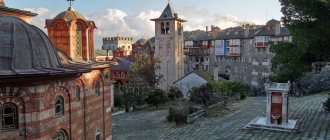In the very center of Russia there is the provincial town of Kostroma with an Orthodox shrine built there, which has a very poetic name: the Epiphany-Anastasia Monastery. The history of this convent is very interesting, and at times tragic...
Since ancient times, Kostroma has been one of the most important centers of the spiritual life of Rus'. It was here in the 13th century that the appearance of an all-Russian Orthodox shrine took place: the miraculous Feodorovskaya Icon of the Mother of God, the prayer image of the blessed Prince Alexander Nevsky.
At different times, there were about 60 (!) Orthodox monasteries on the lands of this region. And all of them were erected by the closest associates of Sergius of Radonezh and his disciples.
History of the monastery in the XV-XVIII centuries
The very first monastery on the outskirts of Kostroma was for men. It was created by one of the students of Sergei of Radonezh and his relative Nikita, who, already an old man, came to Kostroma land from Borovsk. This happened in 1426.
The exact date of death of this Christian ascetic has not been preserved, but it is known that the respected Nikita of Kostroma was buried in the very first cathedral of the monastery he created.
Bird's eye view of the Epiphany-Anastasiin Monastery
At first, all the buildings in the monastery were made of wood, and the powerful monastery walls protected Kostroma from enemy attacks. Only in 1559 the brethren collected the necessary funds and received permission from Moscow Metropolitan Macarius to build the first stone church. The five-domed Epiphany collection was built under the leadership of Abbot Isaiah (Shaposhnikov) for six years and was consecrated in 1565. Its main donor was the cousin of the Russian Tsar John IV, the penultimate appanage Russian prince, Vladimir Staritsky.
Four years later, Staritsky and his army went to defend Astrakhan and on the way stopped at the Kostroma monastery. The monks and the abbot gave the sovereign's relative a warm welcome, which, however, became a reason for court intrigue. The tsar's entourage slandered Staritsky, and by order of Ivan the Terrible, he was killed that same year in Alexandrovskaya Sloboda. The monastery also found itself in terrible disgrace. In 1570, most of the monks and abbot Isaiah were executed, burying the latter in the basement of the stone cathedral on the monastery territory.
View of the buildings of the Epiphany-Anastasia Monastery
However, time passed, and, despite difficult trials, the monastery grew and its influence intensified. Therefore, in the 16th century, two women’s monasteries were added to the men’s monastery – Holy Cross and Anastasiina, named after the founder, the daughter of Dmitry Donskoy.
The beginning of the 17th century turned out to be a very difficult and ruinous Time of Troubles for Rus'. In the last days of 1608, the troops of False Dmitry II, led by Alexander Lisovsky, entered the city, broke through the defenses and occupied the monastery. Because the monks and monastery peasants were faithful to the oath given to the Russian Tsar Vasily IV, they were killed and the monastery itself was plundered. The names of the deceased monks and Kostroma residents are still revered by parishioners today.
Later, when the troubles had passed, large construction began throughout the city. Two new monastery churches and a chapel to the Epiphany Cathedral appeared, a belfry and a stone monastery fence with towers were built, which made the monastery a real fortress.
In the 60-70s of the 17th century, a team of isographers, under the leadership of the famous icon painters Sila Savin and Gury Nikitin, decorated the main monastery church with frescoes. But, unfortunately, these wall paintings have not survived. At the same time, the famous fresco icon with the face of the Mother of God was created on the southwestern tower of the stone monastery wall.
Epiphany Cathedral with golden domes
At the beginning of the next, 18th century, a whole series of Peter's transformations took place, and the pace of monastic life slowed down. There was no money to build new buildings, and the number of monks decreased. Only in 1752-1760. financed by E.M. Saltykova built a new one-domed Nikolsky (“Saltykovsky”) church here. So the grieving widow wished to perpetuate the grave of her husband, Major General M.P. Saltykova.
Since 1779, nationwide veneration of the fresco icon of the Mother of God began. The reason for this was a large fire that engulfed the entire city and caused considerable damage to the monastery. Many buildings then burned down in fire, but the Smolensk icon-fresco was not damaged at all. From that time on, the residents of Kostroma believed in its miraculous properties.
Epiphany Cathedral with golden domes, Epiphany Anastasiin Cathedral with dark domes
Shrines of the convent in Kostroma
Territory and temples
Following the Epiphany Cathedral, other churches that were significant for believers began to be revived.
Now on the monastery territory there is the Cathedral of the Epiphany and Anastasia, as well as the Church of the Smolensk Icon of the Mother of God with its amazing fresco icon of the Mother of God, which miraculously survived all the numerous fires within the monastery walls.
In the crypt, under the cage of the fence, a temple was consecrated in the name of St. Nikita of Kostroma, St. Sergius of Radonezh and Great Martyr Nikita.
The Cathedral of the Epiphany and the bell tower in one of the rebuilt old towers have also been revived and opened to believers.
A three-story building with magnificent window casings has also been preserved here. This is the Refectory Building, which was built back in the 17th century. Nowadays the theological seminary of the city is located here.
Feodorovskaya Icon of the Mother of God
The entire path traversed by Kostroma over the past centuries is closely connected with the Feodorovskaya icon of the Blessed Virgin Mary. One of the most famous Russian shrines and the main shrine of Kostroma is located in the Epiphany-Anastasia Cathedral.
According to ancient legends, Prince Yuri Vsevolodovich purchased it near the city of Gorodets in an old wooden chapel. This icon was presented to Grand Duke Alexander Nevsky on the occasion of his wedding and became his prayer image. In August 1263, the main shrine of Kostroma miraculously appeared in the possessions of Vasily Yaroslavovich, who was the younger brother of Prince Yuri Vsevolodovich.
According to legend, the prince was hunting near the Zaprudne River, and there, on a tree, he saw the image of the Mother of God. And shortly before this, residents of Kostroma noticed on the streets of their city a warrior carrying the image of the Mother of God in his arms. The townspeople recognized him as Theodore Stratilates, the great saint and martyr.
The residents of the city carried the newly found shrine through the streets with great honor and placed it in the cathedral church. After this, the icon of the Mother of God began to be called Feodorovskaya in memory of the Holy Great Martyr Theodore Stratilates.
In 1613, the first tsar from the Romanov dynasty, Mikhail Fedorovich, was called to the throne. This solemn event was held in front of the icon of the Most Holy Theotokos. After which the icon of the Mother of God began to be especially revered among representatives of the Romanov dynasty.
It has already become a tradition that on the day of the celebration of the Miraculous Icon on August 29, the residents of Kostroma annually make a religious procession through the streets of the city. Numerous representatives of the clergy, Orthodox residents of Kostroma, as well as numerous pilgrims with prayerful singing carry in front of them the icon of the Feodorovskaya Mother of God.
Tradition says that the miraculous image was written by the hand of the holy Apostle and Evangelist Luke. It is believed that Theodore Icon of the Blessed Virgin Mary has miraculous properties. It can also be called family, since it patronizes everything related to family well-being: it helps with the birth and upbringing of children.
Before her they pray to the Mother of God for the granting of help during difficult childbirth. And sincere, heartfelt prayer never goes unanswered.
Holy relics
It is perhaps difficult to find another such monastery in Russia, where, like Epiphany-Anastasia, so many of the greatest Christian shrines are kept. This is due to the rich historical and spiritual heritage of both the monastery itself and the ancient city.
Local churches contain many shrines of the Orthodox faith: the relics of St. Timon and Nikita of Kostroma, the founder of the monastery and the Heavenly patron of Kostroma.
St. Nikita began his monastic path in the Trinity-Sergius Lavra, under the spiritual mentorship of St. Sergius of Radonezh. With the blessing of his mentor, he was abbot of the Serpukhov Vysotsky Monastery for 19 years. Then for 7 years he ruled the Borovsky Vysotsky Monastery, where he spiritually raised the great saint of the Russian land, Paphnutius Borovsky.
In the Cathedral of the Anastasia-Epiphany Monastery there is a shrine with the holy relics of St. Timon, Elder of Nadeevsky, who has long been revered on Kostroma soil. A disciple and spiritual friend of the great saint of the Russian land, Venerable Seraphim of Sarov, during his lifetime Hieromonk Timon was endowed with clairvoyance, the gift of miracles and healing. The words with which the Sarov elder admonished Hieromonk Timon are known:
“This, Father Timon, this, everywhere. Sow the wheat given to you. Everything will vegetate somewhere and grow, and bear fruit, although not soon.”
The unique reliquary cross carefully preserves the relics of another 278 saints. According to legend, the holy particles were collected by a locally revered ascetic: Schemamonk Savva.
Also especially revered is a rare reliquary fold with particles of the Robe of the Lord, the Robe of the Virgin Mary and Her belt.
Myrrh-streaming icons
Not far from the shrine with the relics of St. Nikita there is a holy image of his relative and spiritual teacher - St. Sergius, abbot of Radonezh. On the icon there is an ark with a particle of the relics of the Great Elder, which was given to the monastery by His Holiness Patriarch of Moscow and All Rus' - Alexei II.
It was this icon that was destined to become the first myrrh-streaming icon within the walls of the Epiphany-Anastasia Monastery. This happened on July 17, 2000, on the eve of Saint's Day. Myrrh flowed from the blessing fingers of St. Sergius of Radonezh. Since then, the myrrh-streaming of this icon has been repeated to this day.
The icon of St. Seraphim of Sarov, which is located in the monastery, also streams myrrh. And in total, 11 images are streaming myrrh in the Cathedral today. Among them are the icon of St. Nicholas the Wonderworker, Equal-to-the-Apostles Prince Vladimir, and the Kazan Icon of the Mother of God.
This revered list of the Mother of God has an amazing destiny. The shrine of one of the Kostroma monasteries, destroyed during the years of persecution of the church, was preserved by one Christian woman. Having turned the face of the Mother of God, she adapted the icon under the table on which she was cutting vegetables.
Therefore, the Kazan Icon of the Mother of God has survived to this day, chopped up, but at the same time well preserved. And for 13 years now, holy and healing myrrh has been appearing on it!
The myrrh-streaming cross miraculously exudes a fragrant aroma.
Most of the icons in the Cathedral date back to the 17th century. Many were returned to the church from the rich museum funds of Kostroma or brought from holy places as a gift and consolation to the Kostroma people. These include the ancient miraculous Iveron Icon of the Mother of God and the image of the Great Martyr Panteleimon, known for his ability to heal people from ailments. Both shrines were previously located on Mount Athos.
In the Epiphany-Anastasia Cathedral there are icons with particles of the relics of the Holy Blessed Matrona of Moscow and the Venerable Olympias of Arzamas, the heavenly patron of Kostroma Theodore Stratilates. And also the Venerable Martyr Anastasia of Rome, revered on Kostroma soil, in whose honor one of the altars of the Cathedral was consecrated.
Life of the monastery in the 19th-20th centuries
From 1814, for 33 years, students of the Theological Seminary lived and received education in the monastery, and the abbots of the monastery were considered its rectors. During these years, through the efforts of Archimandrite Macarius (Glukharev), one of the towers of the monastery fence was rebuilt into a beautiful single-domed church, which was dedicated to the Smolensk Icon of the Mother of God.
In the autumn of 1847, the inhabitants of the monastery faced a difficult test - another big fire, which almost completely destroyed all the monastery buildings. The damage was enormous, the monastery had to be closed, and the monks had to be transferred to the Bogoroditsky Igritsky Monastery, located near Kostroma. And only in 1863, 16 years later, they decided to restore the monastery, but as a women’s monastery.
It was named Epiphany-Anastasiina, and Abbess Maria (Davydova) was appointed its first abbess, under whose leadership the restoration of the monastery destroyed in the fire began.
Church of the Smolensk Icon of the Mother of God. In the background: the bell tower on the left, the Epiphany Cathedral on the right
This difficult work took about a decade and a half, and the monastery was rebuilt only in the 1880s. Old buildings were restored and new ones were erected on its territory. And the monastery became famous among local residents as a center of Christian service. At the beginning of the 20th century, it operated courses for nurses and the very first hospital in Russia helping rural residents.
In 1918, the new Soviet state closed the monastery, and its main church, the Epiphany Cathedral, remained a parish church for another six years. During these difficult years, Vasily Razumov was the priest here. Later he was arrested, convicted, and in 1937 he was shot.
Monastery bell tower
In 1925, the Kostroma regional archives were placed in the former cathedral. Over the next few decades, the walls of the monastery were destroyed, and St. Nicholas Church and the chapel were completely dismantled. Without proper care and repair work, the cathedral deteriorated and collapsed. But the most severe damage to it was caused by a fire that occurred in the regional archive in 1982. Then the fire destroyed the last frescoes of the 17th century.
The decision to revive the monastery was made in 1990, and the very next year the first nuns from Estonia
. At the same time, the consecration of the cathedral took place, and it was given cathedral status in the diocese. A little later, one of the main Orthodox shrines was moved to this temple - the iconographic image of the Fedorov Mother of God, considered the ancestral shrine of the royal Romanov dynasty. And in the early 2000s, a monument to the patron saint of the city of Kostroma, Feodor Stratilat, was erected on the monastery territory.
Monastery Gate
The second birth of the holy monastery
Only in 1991, before the Council of the Kostroma Saints, for the first time since 1925, a church service was held in the Epiphany-Anastasia Cathedral. And a few months later, in a religious procession with the participation of a large number of people, the Feodorovskaya Icon of the Mother of God, an outstanding Kostroma shrine, was solemnly brought into the cathedral.
It was with this historically significant, miraculous icon that the first king of the Romanov dynasty, sixteen-year-old Mikhail, was blessed to reign.
The Epiphany-Anastasia Convent today is a pearl in the architecture of ancient Kostroma and the center of the spiritual life of the city.
Architectural monuments on the territory of the monastery
The majestic five-domed Epiphany Cathedral is the oldest stone building in Kostroma, surviving to this day (1565).
Researchers believe that Moscow craftsmen took part in its construction.
This four-pillar temple is distinguished by the grandeur of its forms and proportions, and its facades are completed with graceful keel-shaped zakomaras. True, at a later time the roof covering was replaced with a practical hipped roof. Over the course of its long history, several extensions were made to the cathedral, and the largest construction work took place between 1864 and 1869. Now the cathedral has four altars, and it is in it that the famous image of the Fedorov Mother of God is kept.
In addition, on the monastery territory there is a single-domed church dedicated to the Smolensk Icon of the Mother of God (1825). The same one that was rebuilt from a tower on a stone wall. At one time, it was built with money allocated by the rich Kostroma merchant F.M. Obryadchikov, and the construction was supervised by city architect P.I. Fursov. Initially, the temple was built in the classicist style, but after a fire in 1887, it was rebuilt in the Russian-Byzantine style.
Domes of the Epiphany Cathedral (golden domes), Epiphany Anastasia Cathedral (dark domes)
The tall picturesque bell tower (1864) stands out especially on the monastery territory. It has a hipped roof with an elegant gilded dome and a clock in one of the openings for bells.
Description of the architecture
The appearance of the monastery complex has undergone many changes in its lifetime. His yard resembles an elongated trapezoid. The oldest building that has survived to our time is the Epiphany Cathedral. It is distinguished by its restrained appearance.
The roof of the temple is crowned with onion-shaped golden domes. There is a basement below.
Currently, on the territory of the monastery there is also a bell tower, the Church of the Smolensk Icon of the Mother of God and the Cathedral of the Epiphany. Before the revolution, there was the Baroque St. Nicholas Church, the Cathedral of St. John the Evangelist and the Church of the Three Saints.
Current status and visiting hours
The monastery is active. More than a hundred nuns and an abbess live there permanently, and church services are held daily. The Theological Seminary and the administration of the Kostroma diocese are located on the monastery territory. In addition, the monastery has an almshouse for elderly women and a shelter where orphan girls live and study.
Epiphany Anastasia Cathedral
Entry into the monastery territory is prohibited for outsiders. Pilgrims and tourists can only visit the chapels and external entrances of the Epiphany Cathedral.
Close connection with Russian history
Do you want to feel the scent of centuries? Visit here! This is a historical place where you just want to stand, listen to the silence and discover yourself.
Visitors are not allowed into the monastery territory. At least when we got here in the evening, the entrance was closed. But in the Epiphany Cathedral and the chapel near it, open to guests, there is much that deserves your attention.
Surprisingly, this is really so - the church exudes a pleasant aroma and 11 icons stream myrrh!
How to get to the monastery
The monastery is located on the street. Simanovsky (Bogoyavlenskaya), 26.
By car. The road from the capital to Kostroma takes 4.5-5 hours (346 km) and passes along the Yaroslavl highway and the M8 highway (Kholmogory). In Kostroma, you need to cross the road bridge to the left bank of the Volga and turn onto the street. Sovetskaya and follow it to Susaninskaya Square. Simanovsky Street leads from the square to the monastery.
Abbot's corps
By train or bus. From Yaroslavsky railway station in Moscow
Trains reach Kostroma in 6.04-6.35 hours. In addition, from the capital's Central Bus Station, located near the Shchelkovskaya metro station, Kostroma can be reached by regular buses (7 trips per day). This journey takes 6.50 hours. The Kostroma bus station is 1 km away from the railway station. Bus No. 1 and trolleybuses No. 2, 7 (stop "Ul. Pyatnitskaya"), as well as bus No. 2 (stop "Factory-Kitchen") go around the city to the monastery.
Attraction rating:
Rating 3.50 [2 vote(s)]
| ← KOSTROMA | KOSTROMA REGION | RUSSIA → |
How to get there, where it is
Schedule of services:
- 7:30 - Midnight Office, Hours, Divine Liturgy;
- 17:00 — Vespers and Matins
Address of the monastery: city of Kostroma, Bogoyavlenskaya street (or Simanovsky street), house 26. You can travel around the city by bus 2 to the Cathedral stop, or by trolleybus 2 or 7 to the stop called Pyatnitskaya Street.
Coordinates: 57.77295, 40.92429.
You can find all the sights of Kostroma on the city map (you can enlarge it by clicking on “+” to better view the territory).
For a relaxing trip, we decided to stay for 3 days in Kostroma in an apartment that we booked on a daily housing website and were very pleased with both the hostess and the apartment! You can look for a hotel or apartment using, for example, the Booking service. There are many options for accommodation in Kostroma!
Our trip to the Epiphany Monastery of Kostroma took place on July 17, 2021. We stopped by here after a walk in the open-air museum of wooden architecture, which is called Kostromskaya Sloboda.
Tomorrow morning we plan to stop by the Sledovo estate, which is located not far from Kostroma. Are you ready to continue your walk with us? Then go ahead!
Other sights of the Kostroma region, where I was able to visit, are on this map.
Share in the comments which churches and monasteries you have ever visited and which of them made the most unforgettable impression.
Church of Alexius, Man of God
Alexey, the Man of God, is a Christian saint, revered by both the Orthodox and Catholic churches. He lived in the 4th century and led an ascetic lifestyle.
In 1653, a Church was built in honor of the saint on the farmstead of the Epiphany Convent. Money for construction was collected by parishioners in the form of donations.
Today, excursions are held in the Temple, a Sunday school operates, and social work is carried out. Services are held every day. The liturgy begins at 9:00, the evening service at 17:00.
Abbots
Monastery:
- Macarius (Kuchin) (1618 - 1624)
- Haggai (Kolosovsky) (1771 - 1773)
- Macarius (Glukharev) (1821 - 1824)
- Evgeny (Bazhenov) (September 15, 1824 - 1829)
- Afanasy (Drozdov) (July 27, 1829 - 1837)
- Platon (Gorodetsky) (December 20, 1837 - 1839)
- Nathanael (Savchenko) (May 5, 1839 - 1845)
- Agafangel (Soloviev) (September 21, 1845 - February 19, 1849)
Convent:
- Innocentia (Travina) (mentioned 2014)
Church of the Savior in Rows
The uniqueness of this church is that it is located not in the architectural ensemble of temple buildings, but among merchant shopping arcades.
A wooden church stood on this trading place in the 17th century; the temple was erected and consecrated in 1776. Subsequently, the church continued to be built.
After the revolution, the building housed a museum of atheism, and later warehouses. The building acquired its previous appearance only in the 80s.
Divine services in the Temple of the Savior Not Made by Hands are held on Sundays and holidays.
Kostroma is included in the traditional route of the Golden Ring. Photos of Kostroma temples can be seen on magazine covers.
